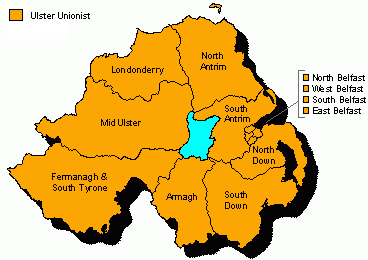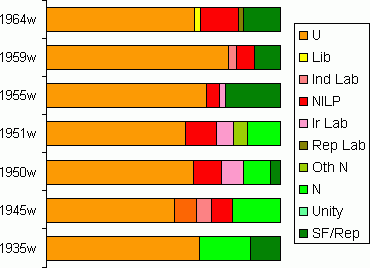

 |

|
| |
| |
Meanwhile in Northern Ireland, under continuing pressure North and South and with many leading activists interned or gaoled, the IRA called off its Operation Harvest campaign on 26 February 1962. Ruairi O’Bradaigh read official statement announcing withdrawal of “all full-time active service volunteers” while also pledging “eternal hostility to the British forces of occupation in Ireland”. The IRA campaign had failed to garner widespread Catholic support and having successfully weathered the storm, many believed there existed a unique opportunity for the government of Northern Ireland to encourage greater Catholic participation in the institutions of the state. However, many in the government, including Brookeborough himself, continued to regard all Catholics as potential traitors who could not compromise their traditional views and embrace the state.
Although electorally unassailable the Unionist Party began to face some internal dissent. In a slowing economy and with unemployment on the rise, some viewed the Brookeborough government as stagnating, more interested in celebrating the 50th anniversary of the Ulster Covenant than tackling the economic challenges of the day. Under mounting political pressure and with failing health, Brookeborough resigned as Prime Minister after 20 years in office on March 26 1963. He was replaced by Captain Terence O’Neill who represented a new liberal Unionist generation. The new Prime Minister stated that the aim of his government was to increase prosperity through rejuvenation of the economy and to build bridges between the two traditions.
The result of the 1964 general election in Northern Ireland was once again a clean sweep for the Unionists who won all 12 seats; a feat that has not since been repeated. However, on an increased turnout of 71.7%, the Unionists saw their vote drop to just under 63% compared with 77.2% in 1959. Sinn Fein was now a proscribed organization so its members contested the election under the label ‘Republican’ and captured 15.9% of the poll. Meanwhile the NILP recorded their best ever result in a Westminster election, capturing 16.1% of the popular vote.

This map by Conal Kelly shows
the winner in each constituency in 1964.
| Party | Votes | % Share | Seats Won | |
| Unionist | 401,897 | 63.2% | 12 MPs | (Armagh
, East Belfast, Fermanagh & South Tyrone,
Londonderry, Mid Ulster,
North Antrim,
North Belfast, North Down, South Antrim, South Belfast, South Down and West Belfast) |
| NILP | 102,759 | 16.1% | ||
| Republican | 101,628 | 15.9% | ||
| Liberals | 17,354 | 2.7% | ||
| Republican Labour | 14,678 | 2.3% |

Other sites based at ARK: ORB (Online Research Bank) | CAIN (Conflict Archive on the INternet) | Northern Ireland Life and Times Survey
Your comments, please! Send
an email to me at nicholas.whyte@gmail.com.
Conal Kelly, 1 June 2007.
|
Disclaimer:©
Nicholas Whyte 2005 Last Updated on Saturday, May 07, 2005 09:42:49
|